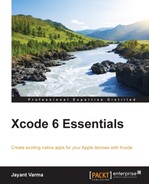Welcome to Xcode 6 Essentials. Development has moved on from the realm of computer science students to practically everyone. A couple of decades ago, computers were expensive and hard to use and now everyone has one in their pockets. Similarly, developmental tools have also changed and made life easier and allowed people from many other aspects to get with developing. With the popularity of iOS devices and Macs, the lure of being the App Store millionaire appeals to one and all. With a growing number of developers using Xcode, Apple has been adding a lot of features to it. In 2014, Apple released Xcode 6 and Swift. This book will cover using Xcode, and the language of choice is Swift. This book will take the reader through the various aspects of Xcode that might be important to use. The book employs a combination of a step-by-step approach and a theory approach to help the reader develop.
Chapter 1, Introduction to Xcode, introduces what Xcode is all about. It helps you install Xcode, if you do not have it on your system, and set it up for use.
Chapter 2, Tour of Xcode, offers a quick tour of the Xcode UI, the various panels, windows, and settings. This is what you will interact with on a regular basis when developing. It is helpful to know the shortcuts, what each displays, and how to activate or deactivate the windows.
Chapter 3, Playgrounds, takes you through a quick journey of Swift, allowing you to learn Swift interactively using the new feature called Playgrounds. This allows you to see the results of your commands and variables; your code is run in the background with no need to compile and run it.
Chapter 4, Interface Builder, introduces Interface Builder and Storyboards. It further helps non-developers or beginners to create applications with little to no code. This can also be used to create functional mock-ups as required.
Chapter 5, Custom Controls, introduces another new feature added to Xcode: the inclusion of custom controls and live previews. This chapter helps you understand the stub of a custom control and then add code. It further explains how to create this as a framework.
Chapter 6, Debugging, helps you as you progress and write your code, given the possibility of errors creeping in. Powerful debugging tools are introduced; they will help you understand where to look for basic help and will set up breakpoints, monitor variables, and quick look values.
Chapter 7, Building and Running, helps you understand the next step after creating your application: packaging it for distribution to the App Store. After going through this chapter, you will have run a full life cycle introduction to creating an application for iOS devices using Xcode.
Appendix, Conditional Execution and Interface Designing, has some interesting gotchas and tips for using Xcode more efficiently and also learning how the current versions differ from previous versions of Xcode and SDK.
